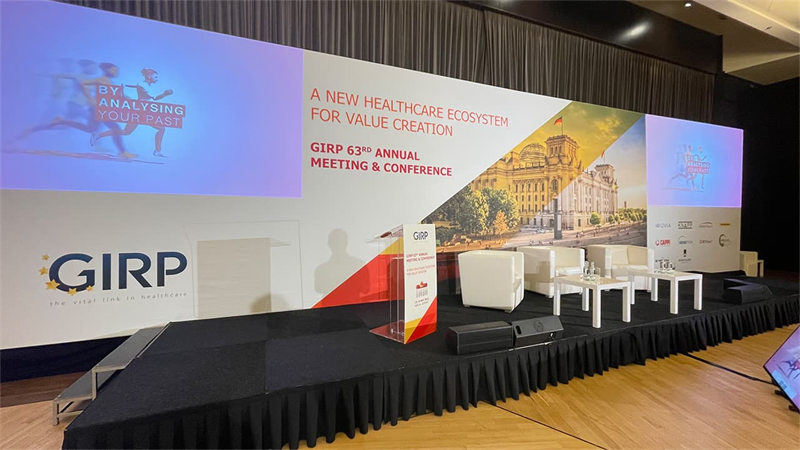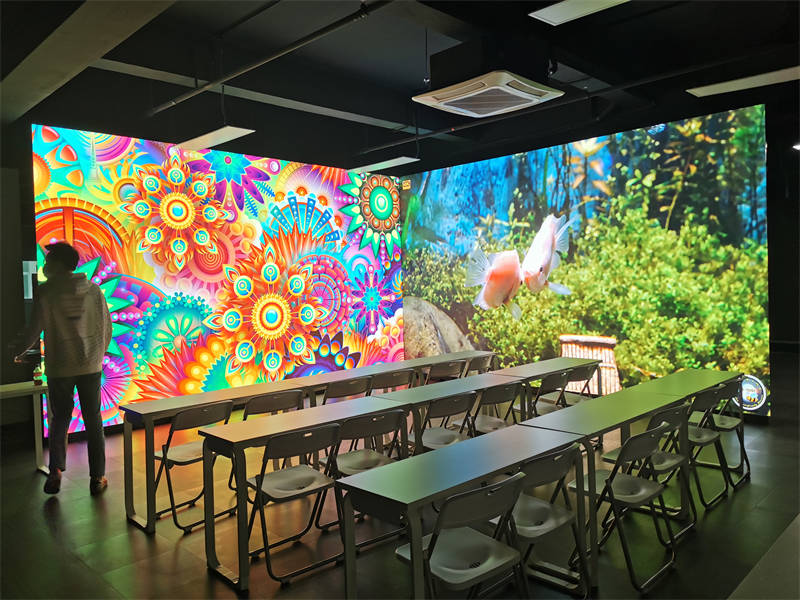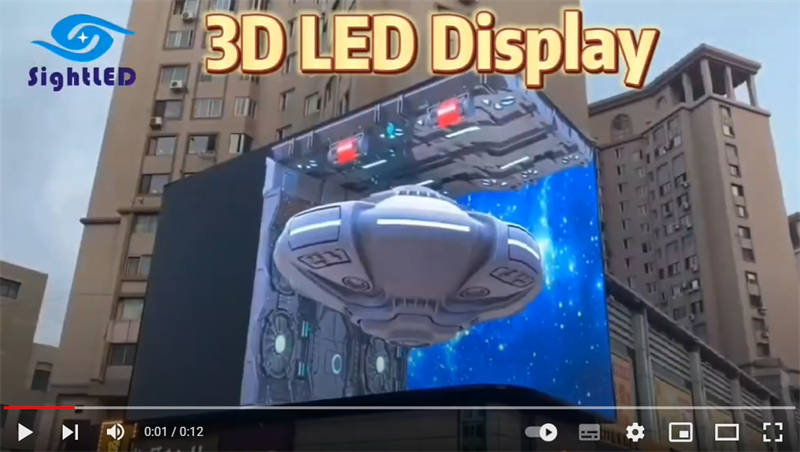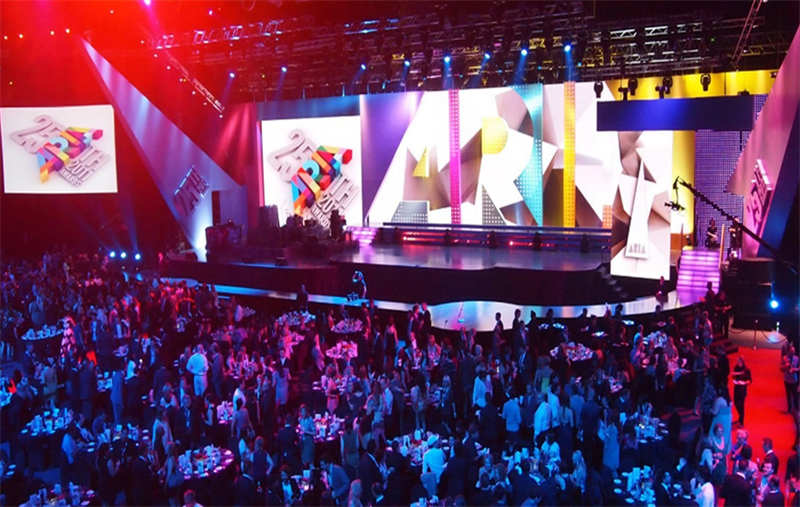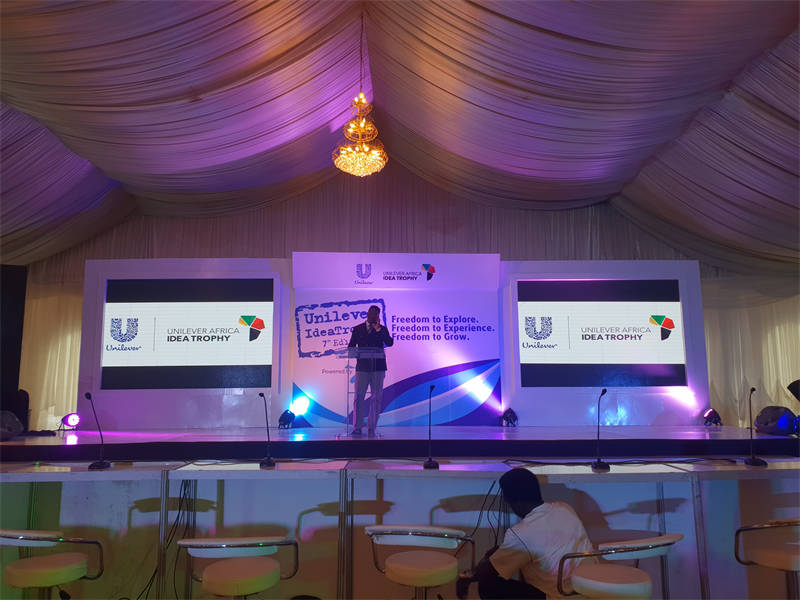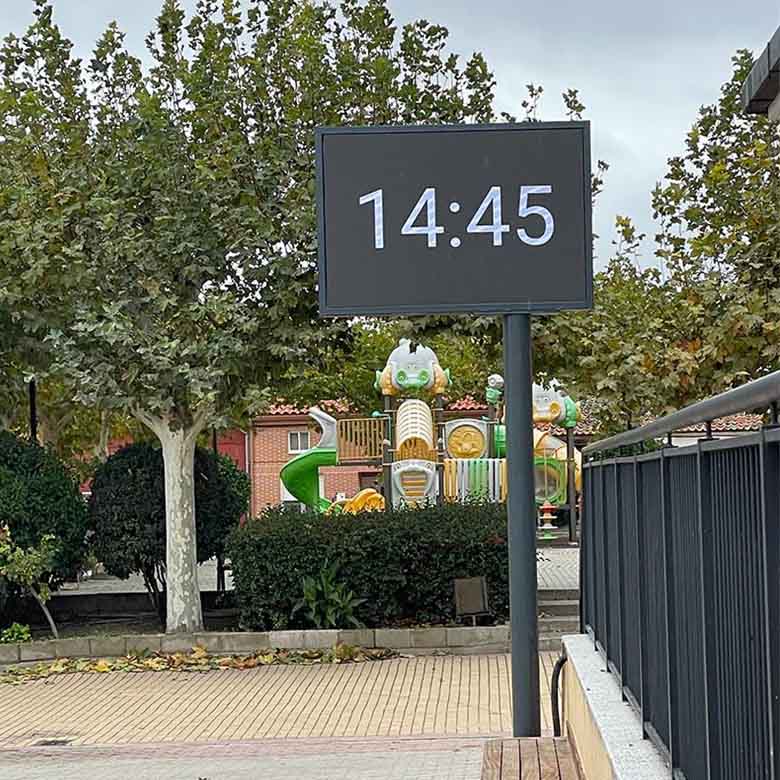Project Case: Outdoor Glass Curtain Wall LED Transparent Screen
When designing the glass curtain wall LED transparent screen, important factors such as display content, space conditions, screen size, and pixels must be considered. At the same time, it is necessary to ensure that the production process and technical indicators are suitable for the actual application needs of the glass curtain wall, combined with the project cost, Carry out reasonable design.
This article combines the engineering experience of Lianman Optoelectronics to analyze the design, installation, testing and maintenance of outdoor glass curtain wall LED transparent screens.
Table of Contents
Toggle1.Basic situation of the project
1.1 Project environment analysis
The glass curtain wall display system is divided into one part, the main screen, which is located directly above the entrance of the shopping mall. The main screen construction requirement is advertising playback, and the brand merchants stationed in the mall place advertising playback. The glass curtain wall structure of this project is: four-point supported glass curtain wall.
The front display of the curtain wall is 10 meters high and 15 meters wide. The designed main screen display area is 150 square meters. The height of the screen from the ground is 3.5 meters. The front of the screen is facing the road intersection. The audience is the flow of people and vehicles passing around the mall and those entering the mall. For the flow of people, the shortest effective viewing distance is about 8 meters.
1.2 Project operation requirements
- It is necessary to ensure that the outdoor view from inside the building is not blocked.
- Reduce the weight of the equipment and require that the original frame structure of the glass curtain wall is not affected.
- The LED transparent screen is installed inside the curtain wall for outdoor viewing.
- The site space is narrow, and on-site installation and subsequent maintenance need to be considered.
- All-weather playback is required, and the display brightness of the large screen is moderate to ensure comfortable viewing for a long time.
- Key technologies affecting curtain wall LED transparent screen display
2.1 Point spacing
In recent years, with the improvement of LED transparent screen manufacturing technology, the resolution of transparent screens has been continuously improved. The design of LED transparent screens has been upgraded from the initial selection of the maximum transmittance solution to the selection of the most appropriate solution that takes into account both transmittance and dot spacing.
| Model | Pixel pitch | Minimum viewing distance (m) | Optimal viewing distance (m) | Pixel density | Transparency Screen area | SD 1280X720P | HD 1920X1080P |
| OUTDOOR GLASS SL-A | P3.97*8mm | 8 | 16~32 | 16128/㎡ | 78% | 57.14㎡ | 128.6㎡ |
| OUTDOOR GLASS SL-A | P5.2*10.4mm | 10 | 20~40 | 11664/㎡ | 82% | 79㎡ | 177.8㎡ |
| OUTDOOR GLASS SL-A | P10.4mm*P15.6mm | 16 | 30~64 | 4096./㎡ | 88% | 225㎡ | 506.3㎡ |
The following is a comparison of typical Sightled OUTDOOR GLASS SL-A specifications.
OUTDOOR GLASS SL-A has three specifications and models: P3.97*8mm/ P5.2*10.4mm/ P10.4mm*P15.6mm. Pixel spacing is the distance between lamp beads and is directly related to pixel density. The minimum viewing distance is the distance at which the human eye cannot distinguish pixel particles, but long-term viewing at this distance will damage the eyesight. The optimal viewing distance is the comfortable distance for viewing the screen, and it is also the clearest distance.
It can be seen from the comparison in Table I that the smaller the pixel spacing is, the higher the pixel density is. On the same 38.5 square meter transparent screen body, P3.97.8mm can display a clearer picture. To display the same standard definition screen (1280X720P), P5.210.4mm needs to be enlarged approximately (79/57.14) = 1.38 times; high-resolution display requires high-performance image processing equipment, and the overall cost of the system will also increase.
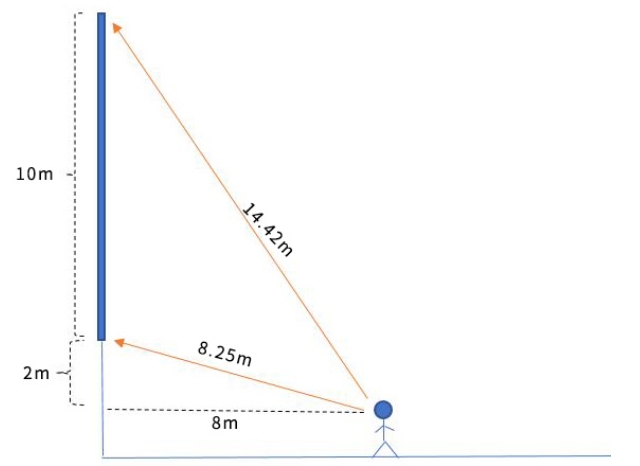
It is estimated from the above figure (minimum viewing distance diagram) that the screen display height is 10m, and the nearest vertical distance of the human line of sight is 8m. It can be calculated that the minimum viewing distance is between 8.25m and 14.42m. Considering the minimum viewing distance and budget, there is no need to use the P3.97.8mm product. The Sightled OUTDOOR GLASS SL-A P5.210.4mm product is recommended as the main product of the elevator sightseeing screen. Moreover, from the perspective of resolution and transmittance of the two products, the difference is not very obvious. At a viewing distance of 20m and above, the effects of the two are basically the same.
What is Outdoor glass SL-A series
Aluminum & Light Weight Cabinet
SightLED LED transparent LED screen features a standard cabinet design of 500×1000mm and 1000×1000mm, showcasing a sleek and practical appearance. With a weight of just 12kg/㎡ and an ultra-thin aluminum cabinet measuring 61mm in thickness, it offers a lightweight and slim solution
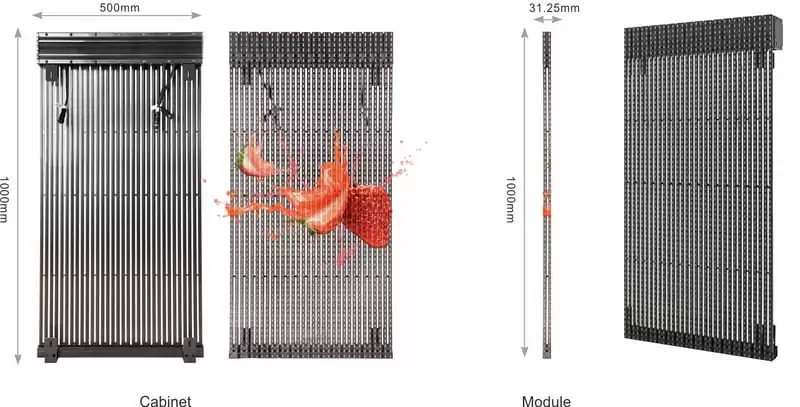
High performance
Employing DIP LED lamps which offers high brightness, a long lifespan, and excellent waterproof capabilities
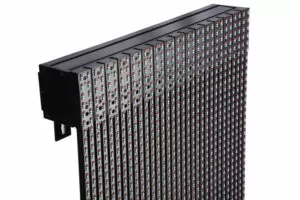
Quick installation
Fast connectors connection for quick installation and maintenance, increased durability, and extended lifespan.
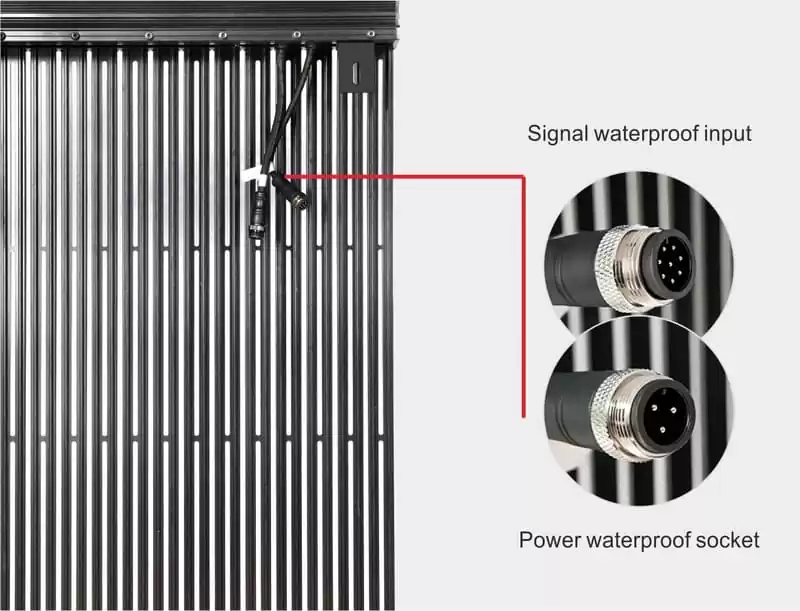
2.2 Packaging technology
One factor that determines the quality of LEDs is the main materials, such as chips, gold wires, etc., and another factor is the packaging process. Pixel packaging technology is related to the color saturation, viewing angle and other display effects of the entire display screen, as well as production costs, quality stability, etc., and is one of the most critical indicators for selecting LED transparent screens.
The mainstream packaging technology for LED transparent screens is surface mount SMD mode. Surface mount refers to pasting the packaged light-emitting tube on the circuit board, and then processing the integrated circuit welding process into the screen body. It has good heat dissipation and uniform color, and the entire display screen can be maintained from the front, which greatly reduces maintenance costs and difficulties;
It is divided into SMD front-side stickers and SMD side-sticks. Positive-emitting lamp beads are generally commonly used in the LED industry. The technology is mature and uses matte technology, which can suppress reflection and display good color effects. The side-emitting lamp beads are specially designed for LED transparent screens; the side pins are UV-resistant and have a white frame (to increase brightness), with higher transmittance and high reliability.
The SMD front sticker is transparent no matter from which angle it is viewed, giving it an advantage in viewing angles. SMD side stickers look more transparent at certain angles, and the transparency at certain angles will be blocked by the light panel; they have an advantage in fixed viewing angles.
Sightled OUTDOOR GLASS SL-A P5.2*10.4mm uses side-emitting technology to obtain higher transparency, fully satisfying the unobstructed view of people in the elevator. In addition, in terms of user-friendly maintenance design, it supports separate disassembly of light bars, supports hot swapping, and is easy to replace and maintain. It is the last guarantee of product stability and can better meet actual needs when the elevator space is limited.
2.3 Design of LED control circuit
The LED control part is the core part that determines the display effect. The control circuit has a built-in high-performance single-chip micro control chip. The controller sends control signals and data to the LED driver chip through the internal control program. After receiving the signal, the LED driver chip takes corresponding actions, thereby achieving independent control of each red, green, and blue LED light-emitting chip.
2.3.1 Drive system
The function of the LED driver part is to receive color data and drive the LED transparent screen to display according to the brightness value represented by the data. There are usually three methods: constant current, regulated voltage, and constant voltage-constant current.
The output current of the constant current drive circuit is constant, and the output DC voltage changes with the load resistance. The entire circuit is not afraid of the load being short-circuited, but the load is strictly prohibited from being completely open-circuited. The voltage stabilizing circuit outputs a fixed voltage, and the output current changes with the increase or decrease of the load. The entire circuit is not afraid of the load opening, but it is strictly forbidden for the load to be completely short-circuited. The constant voltage and then constant current method is the most ideal driving circuit. It not only detects the LED current but also controls the LED voltage, which is beneficial to extending the LED life and reducing power consumption. It is generally used in high-end LED products.
2.3.2 Control system
The display effect of LED depends on the size of the current and voltage passing through it, time, etc., so the control system mainly controls the power output of the LED. At present, LED power supplies designed with PWM (pulse modulation) control method have conversion efficiency as high as 80% to 90%, and the output voltage or current is very stable, which is a high-reliability power supply.
PWM can control the time ratio of LED on and off. By dividing the time ratio into several levels, the LED displays a corresponding number of gray levels (gray scale). The product of the grayscale levels of the three primary colors is the number of colors that the display screen can theoretically reproduce. It is generally 256 levels. When the number of colors reaches 16.7M, 24-bit true color information can be displayed.
Generally, the frequency of PWM is greater than 100Hz, otherwise there will be flickering and scanning lines on the display when viewing. Nowadays, most large screens with 10-bit grayscale have a refresh frequency of 800 to 1000 Hz. Under normal camera viewing and rotation, the LED screen display is stable and flickering-free, and at the highest refresh rate, the grayscale is excessively smooth and no Cross color.
LED transparent screen installation
1.The installation method of shopping mall glass is steel structure frame point support type, refer to the figure below;
2.The curtain wall glass is laminated tempered glass with colorless glue seams. It is relatively bright when viewed from the inside.
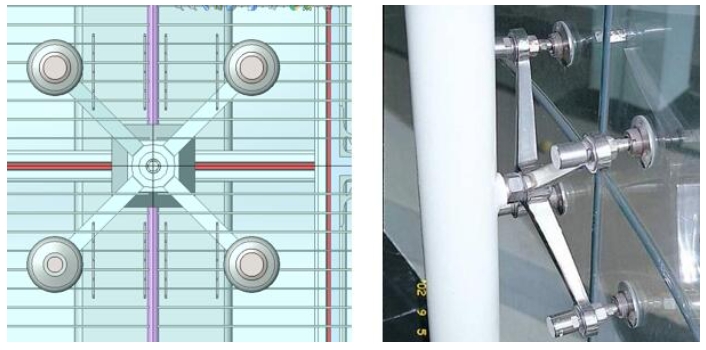
Difficulty:
The cabinet needs a customized design to accurately avoid the glass point support connection claws. After the screen is installed, the space between the connection claws needs to be filled with short light bars to achieve the most complete appearance. display effect.
The dead weight of the LED display is transferred to the main steel frame structure through the connecting parts, and cannot come into contact with the glass and connecting claws to ensure that the stress state of the glass is not affected.
Require:
- For future glass cleaning and damaged glass replacement, keep the transparent screen 30mm-40mm away from the inner surface of the glass;
- The installation of the transparent screen needs to be reliably fixed on the curtain wall structural components;
- Reserve space for maintenance and allow safe access;
- The entire installation surface is required to reduce occlusion and ensure transparency (≥70%).

Glass connecting claw position design:
- Refer to the detailed dimensions of the curtain wall construction drawings and review them with on-site measurements to accurately reserve the position of the connecting claw;
- After installing the unit box on site, use a customized short-size light bar to fill the connecting claw space;
Final reference effect:
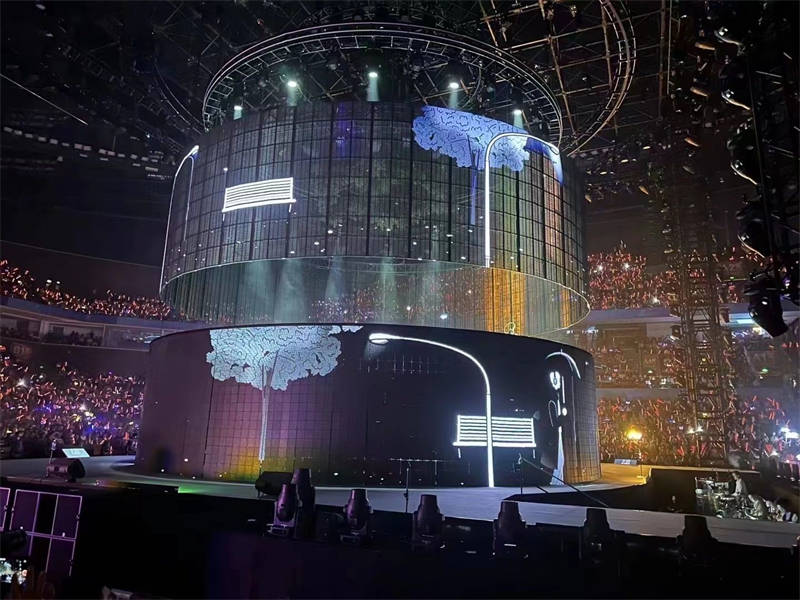
The above is the analysis of glass curtain wall display requirements. Starting from the selection of point pitch, pixel packaging, viewing distance determination, circuit design, installation foundation, etc., I share my experience in the design of Sightled LED transparent screens. I hope it will be helpful to practitioners, engineering companies and other friends. Be helpful and promote communication and progress.

